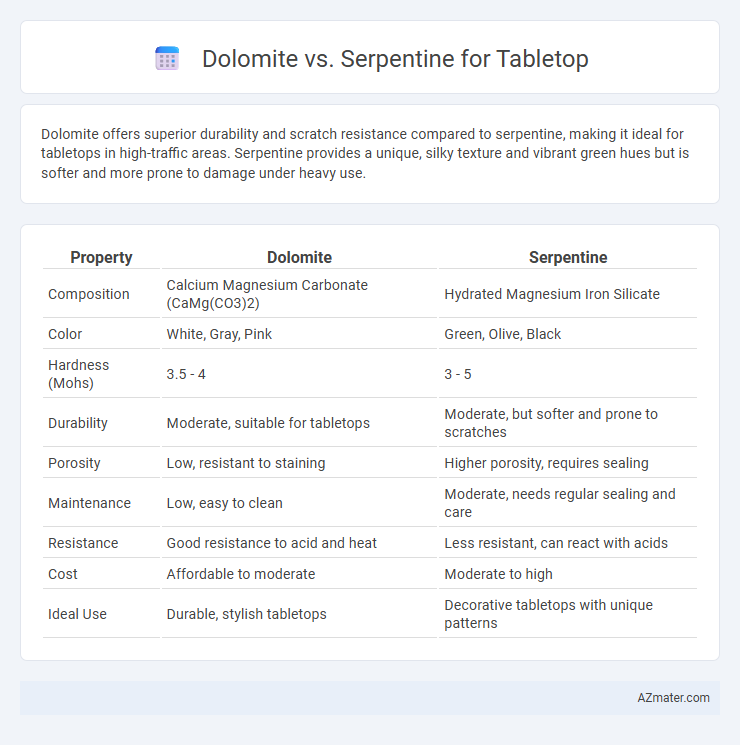Dolomite offers superior durability and scratch resistance compared to serpentine, making it ideal for tabletops in high-traffic areas. Serpentine provides a unique, silky texture and vibrant green hues but is softer and more prone to damage under heavy use.
Table of Comparison
| Property | Dolomite | Serpentine |
|---|---|---|
| Composition | Calcium Magnesium Carbonate (CaMg(CO3)2) | Hydrated Magnesium Iron Silicate |
| Color | White, Gray, Pink | Green, Olive, Black |
| Hardness (Mohs) | 3.5 - 4 | 3 - 5 |
| Durability | Moderate, suitable for tabletops | Moderate, but softer and prone to scratches |
| Porosity | Low, resistant to staining | Higher porosity, requires sealing |
| Maintenance | Low, easy to clean | Moderate, needs regular sealing and care |
| Resistance | Good resistance to acid and heat | Less resistant, can react with acids |
| Cost | Affordable to moderate | Moderate to high |
| Ideal Use | Durable, stylish tabletops | Decorative tabletops with unique patterns |
Introduction to Dolomite and Serpentine
Dolomite is a durable carbonate mineral composed of calcium magnesium carbonate, frequently used for tabletops due to its hardness and resistance to acids and scratches. Serpentine, a group of greenish minerals rich in magnesium silicate, offers a softer, visually striking alternative with its unique variegated patterns and smooth texture. Choosing between dolomite and serpentine for tabletops involves balancing dolomite's superior durability against serpentine's aesthetic appeal and warm, natural hues.
Geological Origins: Dolomite vs Serpentine
Dolomite is a sedimentary carbonate rock primarily composed of the mineral dolomite, formed through the diagenesis of limestone in marine environments over millions of years. Serpentine, on the other hand, is a metamorphic rock derived from the alteration of ultramafic rocks like peridotite through hydrothermal processes, characterized by its greenish hues and fibrous texture. Understanding these distinct geological origins informs the selection of Dolomite or Serpentine for tabletops based on durability, aesthetic, and mineral composition.
Physical Properties Compared
Dolomite features a hardness of 3.5-4 on the Mohs scale, offering moderate scratch resistance, while serpentine rates lower at 2.5-5, indicating variable durability based on composition. Dolomite's density ranges around 2.85 g/cm3, making it relatively heavier compared to serpentine's 2.2-2.9 g/cm3, which affects tabletop weight and stability. Thermal conductivity in dolomite is moderate, ensuring heat resistance suitable for tabletops, whereas serpentine's variable thermal properties can influence heat retention and surface temperature.
Aesthetic Appeal: Colors and Patterns
Dolomite offers a wide range of colors, from soft whites and creams to pinks and greens, often featuring subtle crystalline patterns that enhance its elegant and refined look. Serpentine typically presents rich green hues with unique swirling or veined patterns, creating a striking and natural appearance for tabletops. Both materials provide distinct aesthetic appeal, with Dolomite favoring a more classic, understated style and Serpentine bringing bold, vibrant visual interest.
Durability and Hardness
Dolomite offers higher hardness on the Mohs scale, typically around 3.5 to 4, compared to serpentine's lower range of 2.5 to 4, making dolomite more resistant to scratches and daily wear for tabletop surfaces. Durability-wise, dolomite's crystalline structure provides superior resistance to acids and abrasion, ensuring long-lasting strength under frequent use. In contrast, serpentine, while visually appealing with its unique patterns, tends to be softer and more susceptible to etching, requiring careful maintenance to preserve its integrity.
Maintenance Requirements
Dolomite tabletops require minimal maintenance due to their natural hardness and resistance to scratches and stains, making them ideal for busy environments. Serpentine surfaces demand more frequent sealing and gentle cleaning to preserve their luster and prevent etching from acidic substances. Choosing dolomite reduces long-term upkeep, while serpentine's softer nature necessitates careful handling to maintain its aesthetic appeal.
Cost Comparison
Dolomite tabletops generally offer a more cost-effective solution compared to serpentine, with prices typically ranging from $30 to $60 per square foot, making it suitable for budget-conscious renovations. Serpentine, known for its unique veined patterns and higher durability, commands higher prices averaging $50 to $100 per square foot, reflecting its premium market positioning. The cost difference is influenced by factors such as quarry availability, processing complexity, and desired finish, with serpentine requiring more specialized cutting and polishing techniques.
Environmental Impact
Dolomite countertops have a lower environmental impact due to their abundant natural availability and energy-efficient quarrying processes, whereas serpentine extraction often involves more intensive mining techniques that can disrupt local ecosystems. Dolomite's slower erosion rate contributes to longer-lasting surfaces, reducing the need for frequent replacement and thereby lowering its overall carbon footprint. Serpentine's potential for releasing asbestos fibers during extraction raises environmental and health concerns, making dolomite a more sustainable choice for eco-conscious homeowners.
Best Applications for Tabletop Use
Dolomite offers excellent durability and scratch resistance, making it ideal for high-traffic tabletops in kitchens and dining rooms. Serpentine provides unique aesthetic appeal with its vibrant green tones and smooth texture, suitable for decorative or accent tabletops in living spaces. Both stones require proper sealing, but dolomite's superior hardness makes it better suited for functional use where wear and tear are frequent.
Choosing the Right Stone for Your Tabletop
Dolomite offers superior durability and a polished finish, making it an excellent choice for tabletops that require resistance to scratches and stains. Serpentine features unique green hues and intricate patterns, adding aesthetic appeal but generally requires more maintenance due to its softer composition. Selecting the right stone depends on balancing long-term durability needs with desired visual characteristics for your tabletop.

Infographic: Dolomite vs Serpentine for Tabletop
 azmater.com
azmater.com